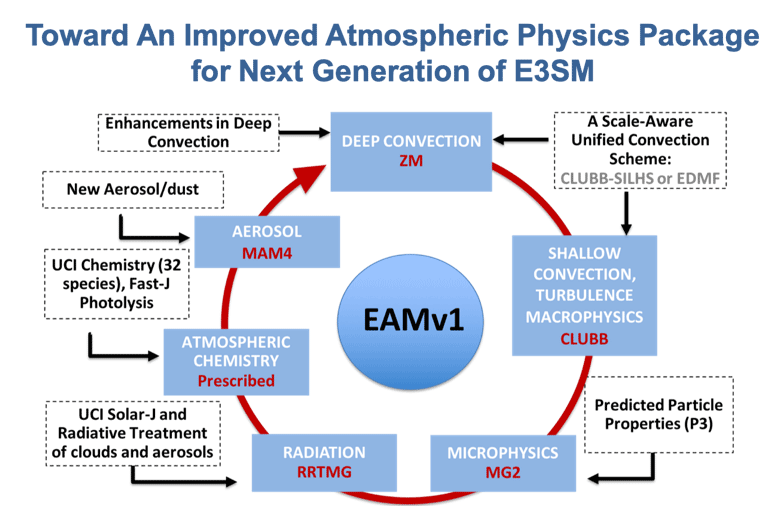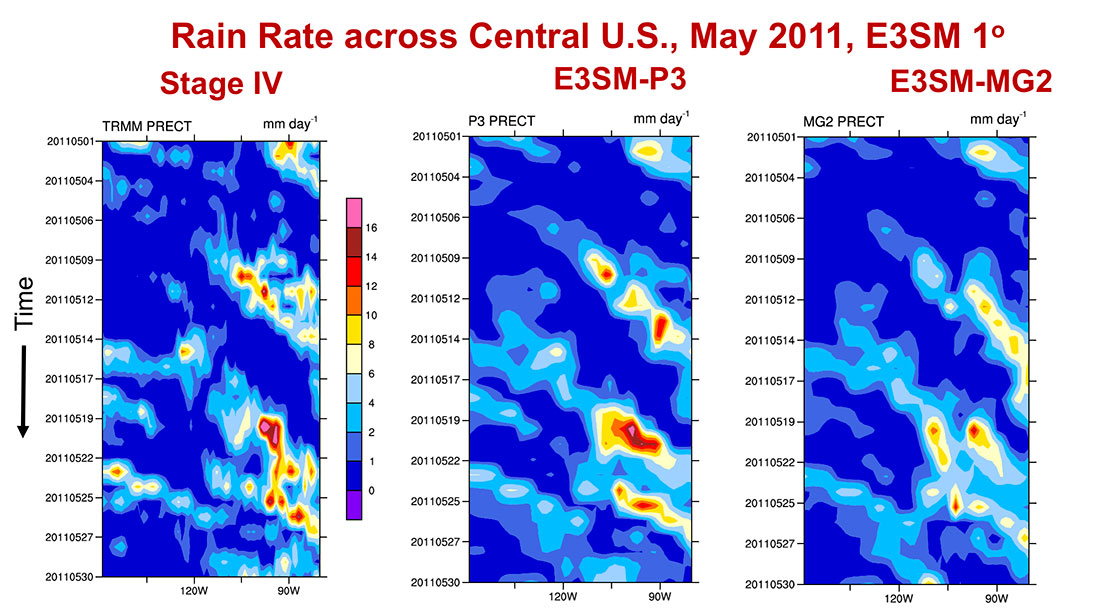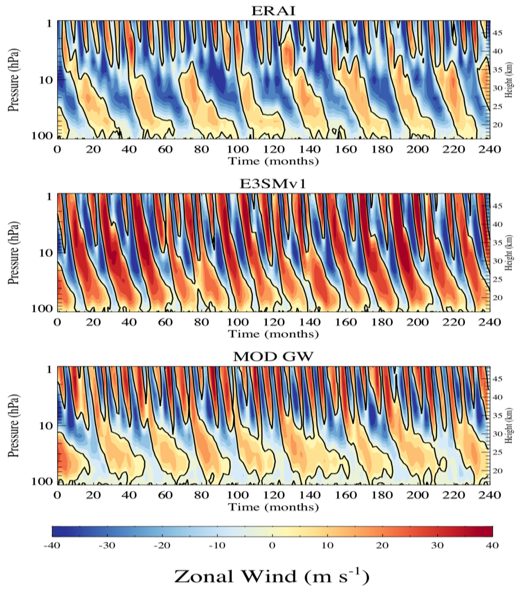NGD Atmospheric Physics

The proposed new physics shown in the dashed boxes will improve the current model (E3SM Atmosphere Model v1 – EAMv1) representation of atmospheric chemistry, aerosols, clouds, radiation, convection, and precipitation processes.
One of E3SM’s Phase Two Next Generation Development (NGD) efforts is to continue improving the current model’s representation of atmospheric physics and enhance the model’s capability to address uncertainty in predicting future changes enabling scientists to address questions across the Water cycle, Biogeochemistry (BGC), and Cryosphere campaigns. The NGD-Atmospheric Physics project, led by Shaocheng Xie of Lawrence Livermore National Laboratory (LLNL), consists of more than 30 scientists from four DOE labs and six academic institutes with a wide range of expertise in atmospheric physics. One focus of the development work is to address model shortcomings and deficiencies responsible for major model biases in the E3SM Atmosphere Model v1 (E3SMv1) including the substantially underestimated stratocumulus clouds, large regional precipitation biases over both land and ocean, and too strong Aerosol Indirect Effect (AIE) among others. Poor scale-awareness of model cloud parameterizations is also being addressed. Another focus is to enhance the capability of E3SM to simulate the climate response to scenarios of interest by implementing an interactive atmospheric chemistry in E3SM and improving the coupling of aerosols, atmospheric chemistry, and BGC. The development work will address the combined problems of scientific accuracy, scale-awareness, and computational efficiency.
A Unified Scale-Aware Convection Scheme

These schematic figures illustrate how CLUBB-SILHS and EDMF unify turbulent and convective processes that occur in the Earth’s atmosphere.
An exciting feature expected from the NGD project is a unified scale-aware convection parameterization, which removes the unrealistic separation between turbulence, shallow convection, and deep convection. The new convection scheme is being developed through two separate efforts based on two candidate approaches: CLUBB-SILHS (Larson, 2017) and Eddy-Diffusivity/Mass Flux (EDMF) (Siebesma and Teixeira, 2000 and Siebesma et al., 2007). The best suitable scheme for E3SM v3/v4 will be selected from these two approaches. CLUBB-SILHS is a unified scheme that allows CLUBB to represent both shallow and deep convective clouds. This scheme uses a Monte Carlo integration technique named the Subgrid Importance Latin Hypercube Sampler (SILHS) to sample the subgrid probability density functions (PDFs) predicted by CLUBB and allows the microphysics to respond to subgrid variability in clouds. EDMF is an optimal combination of the eddy-diffusivity approach representing boundary layer turbulence, and the mass-flux approach representing shallow and deep moist convection. A multi-plume version of EDMF (Suselj et al., 2012), which uses a stochastic entrainment parameterization, will be extended to deep convection by coupling the Mass Flux (MF) component to a full microphysics scheme. Additionally, parallel efforts are being made to continue improving the representation of various convective processes (e.g., triggers, closure, downdrafts, cold pools, stochastic behavior, and momentum transport) in E3SM. These improvements will be incorporated into the new convection scheme once it is developed.
Improved Cloud Microphysics and Aerosol and Dust Physics
A new two-moment microphysics parameterization – the predicted particle properties (P3) scheme (Morrison and Milbrandt, 2015), which has more physically accurate ice microphysics – is being implemented and improved in E3SM. P3 will help address the artificial partitioning of frozen particles into cloud ice and snow and the lack of rimed particles for convective microphysics in the current Morrison and Gettelman version 2 (MG2) microphysics. E3SM scientists further develop P3 into a three-moment microphysics scheme to address the problems caused by the fixed or diagnostic shape of the size distribution for individual hydrometeors. These current issues could contribute to large uncertainties in simulated ice-containing clouds and precipitation (particularly deep convective clouds).
A number of improvements in modeling aerosols and dust in E3SM are also being implemented to better capture their role in the Earth’s water cycle, biogeochemistry, and cryosphere systems in future climates. The advanced aerosol model MOSAIC (Zaveri et al., 2008) will be incorporated into E3SM and coupled to the gas-phase photochemical scheme to simulate processes involved in the treatment of nitrate and other semi-volatile aerosol species. A prognostic capability for simulating volcanic eruption emissions and resulting stratospheric sulfate aerosol will be added. The treatment of dust particles in E3SM will be improved by implementing a dust emission scheme with dynamic soil erodibility for close coupling between land and atmosphere, as well as implementing glacier flour sources and a newer size-resolved dry deposition scheme. Dust iron/phosphorous dissolution and mineralogy will be added to enable aerosol nutrients coupling with ocean/land biogeochemistry and improve dust radiation and ice nucleation. A new explicit, yet computationally efficient, treatment of secondary organic aerosol (SOA) formation is being developed for E3SM, which will be fully coupled with the interactive atmospheric chemistry (see below) and energy/land use.
Improved Solar Radiative Heating
The NGD project will test the Solar-J radiative heating code (Hsu et al., 2017) developed at the University of California, Irvine (UC Irvine) and use it as a benchmark to examine the climate impact of the known limitations of the existing E3SM radiation code (RRTMG). Solar-J features 8 angular streams for scattered sunlight, an innovative cloud overlap scheme, spherical solar ray tracing, and requires no delta-Eddington reduction in aerosol/cloud optical depths. These capabilities should produce scientific improvements over the current RRTMG-SW code, which uses only 2 streams and therefore must correct cloud and aerosol optical depths via the delta-Eddington methodology. Additionally, Solar-J is designed to be robust to changes in vertical resolution (Prather, 2015).
Interactive Atmospheric Chemistry and Improved Photolysis

The time-series of ozone in the stratosphere simulated by E3SMv1 (simulation H1) compares well to ozone measured by a satellite (OMI), indicating that the annual cycle in temperature and the winds in the stratosphere is well simulated by E3SMv1. The stratospheric ozone is calculated using a single chemical tracer (LINOZv2, Hsu and Prather 2009), so it is also very efficient computationally.
An interactive atmospheric chemistry based on the UC Irvine chemistry mechanism, which includes 32 species, will be developed to address the known limitations of the super-fast mechanism in E3SM. This improvement will provide E3SM with: (1) the capability to simulate methane (CH4) based on emissions and climate feedbacks, (2) improved simulation of oxidants for production of aerosols (see section on Improved Cloud Microphysics and Aerosol and Dust Physics above), (3) improved ozone (O3) concentrations, allowing for anthropogenic pollution, and (4) simulation of important greenhouse gases (GHGs) in the stratosphere (methane (CH4) & nitrous oxide (N2O)), which is critical to simulating the climate impact of their changing emissions. In addition, the Fast-J photolysis code, which is needed for the photochemistry, will be implemented in E3SM. Fast-J (Wild et al., 2000 and Bian and Prather, 2002) will be a no-cost add-on to the Solar-J radiative transfer code because both codes share the radiation solver (see the ‘Improved Solar Radiative Heating’ description above), which will also make radiative heating and photolysis consistent in E3SM.
Improved Radiative Treatments of Clouds and Aerosols
The goals are to (1) improve the aerosol optics treatment from internal mixing to shell-core optics, (2) improve the cloud optics treatment to differentiate different clouds, and (3) improve the consistency of the subcolumn treatment in radiation and cloud physics by sampling the subcolumn clouds in radiation and cloud simulators in accordance with the subgrid cloud distribution treatments in the cloud simulation routines.
Model Tuning and Evaluations
Another effort of the NGD-Atmosphere project is to integrate the proposed new features into E3SMv3 once they are developed by individual research teams. Various methodologies (e.g. simulator, PPE, and process-oriented diagnostics) will be developed and used to better understand model behaviors and physics, and to help model evaluation and tuning at both global and process levels.
Notable Accomplishments
Recent developments in atmospheric physics have led to a significant improvement in modeling the following phenomena: the diurnal cycle of precipitation, the propagation of mesoscale convective systems (MCS), and the quasi-biennial oscillation (QBO) of the tropical stratospheric winds. Some of these improvements will be implemented in E3SM v2; the rest in a later version of the model.

This figure shows the timing phase (color) and amplitude (color intensity/saturation) of the first diurnal harmonic of total precipitation (mm/day) over the 48 contiguous United States during the summer from 10 years of 3-hourly averaged data for (a) Satellite Observations (TRMM), (b) Default E3SM (CNTL), and (c) Revised trigger (dCAPE&ULL). The observations show late afternoon to early morning peaks over most of the regions, which are not captured by the default E3SM. In contrast, these model biases are dramatically reduced with the revised convective trigger.
The improvement in the diurnal cycle of precipitation is achieved with a refined convective trigger mechanism, which strengthens the coupling of convection with large-scale dynamics and enables the capability to detect mid-level moist instability by removing the restriction of air parcel launch level within the boundary layer (Xie et al., 2019). In the figure below, the satellite observations (TRMM) show late afternoon to early morning peaks (1600 Local Standard Time (LST) to 0200 LST) over most of the continental U.S. For example, precipitation peaks at late afternoon (1600 LST) in the southeastern U.S. while the precipitation maximum features an eastward propagation from the eastern edge of the Rocky Mountains at late afternoon to the central Great Plains at midnight (105 degrees W to 90 degrees W). The default E3SM Atmosphere Model v1 (EAMv1) tends to produce precipitation too early during the day and fails to capture the nocturnal peak over the Great Plains. These model biases are dramatically reduced with the revised convective trigger. The nocturnal peak over the Great Plains, which nearly all climate models fail to capture, is well simulated with the revised trigger. The diurnal cycle of precipitation over the eastern U.S. is also much improved.

The Hovmöller plot of daily mean precipitation rate cross the central U.S. (averaged over 25N to 50N) in May 2011 from Observations (Stage IV), E3SM-Predicted Particle Properties (E3SM-P3), and E3SM-Morrison and Gettelman version 2 (E3SM-MG2).
The significant improvement in simulating surface rain rate under various atmospheric conditions is accomplished by a new three-moment representation of rain microphysics in the predicted particle properties (P3) microphysical parameterization based on idealized rain-shaft model tests (Paukert et al., 2019). The figure below shows the Hovmöller plot of daily mean precipitation rate cross the central U.S. in May 2011 from the E3SM simulations with the two-moment P3, compared with the original microphysics (Morrison and Gettelman version 2 (MG2)) and observations. The model runs are nudged hindcasts at the E3SM standard resolution (ne30) with 72 vertical levels. P3 simulates larger rain rates, agreeing better with observations. The mesoscale convective system (MCS) precipitation evolution is also better captured with P3.

The quasi-biennial oscillation (QBO) period with the revised convective gravity wave parameterization (MOD GW) (~ 26 months) compared to the ERA-Interim reanalysis (ERAI) (28 months) and the default E3SMv1 (~ 18 months).
The improvement in the quasi-biennial oscillation (QBO) of the tropical stratospheric winds is achieved by a re-adjustment of free parameters in the convective gravity wave parameterization (Richter et al., 2019, submitted). As the figure below shows, the QBO period with the revised convective gravity wave parameterization (MOD GW) is about 26 months compared to 28 months in the ERA-Interim reanalysis (ERAI), which represents a significant improvement relative to that produced by the default E3SM version 1 model which is ~ 18 months.


